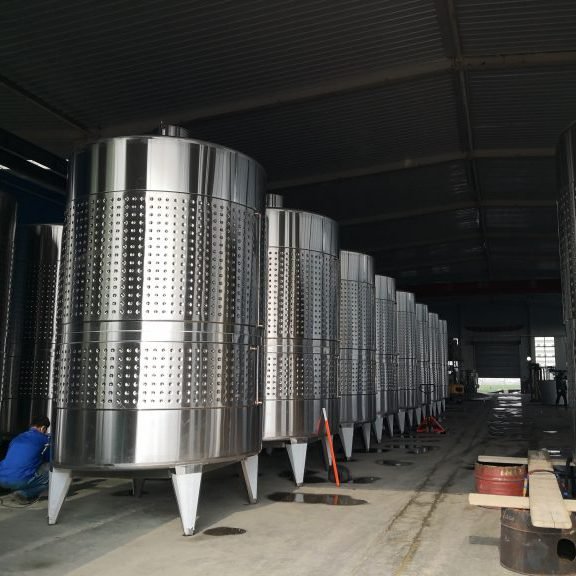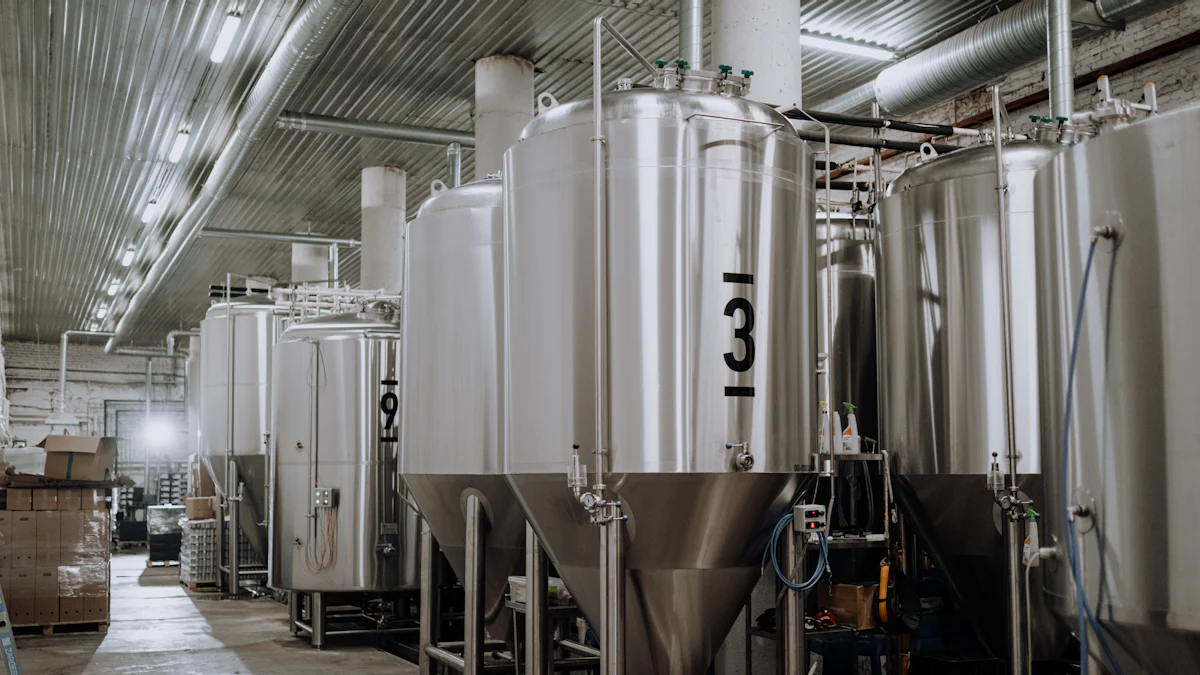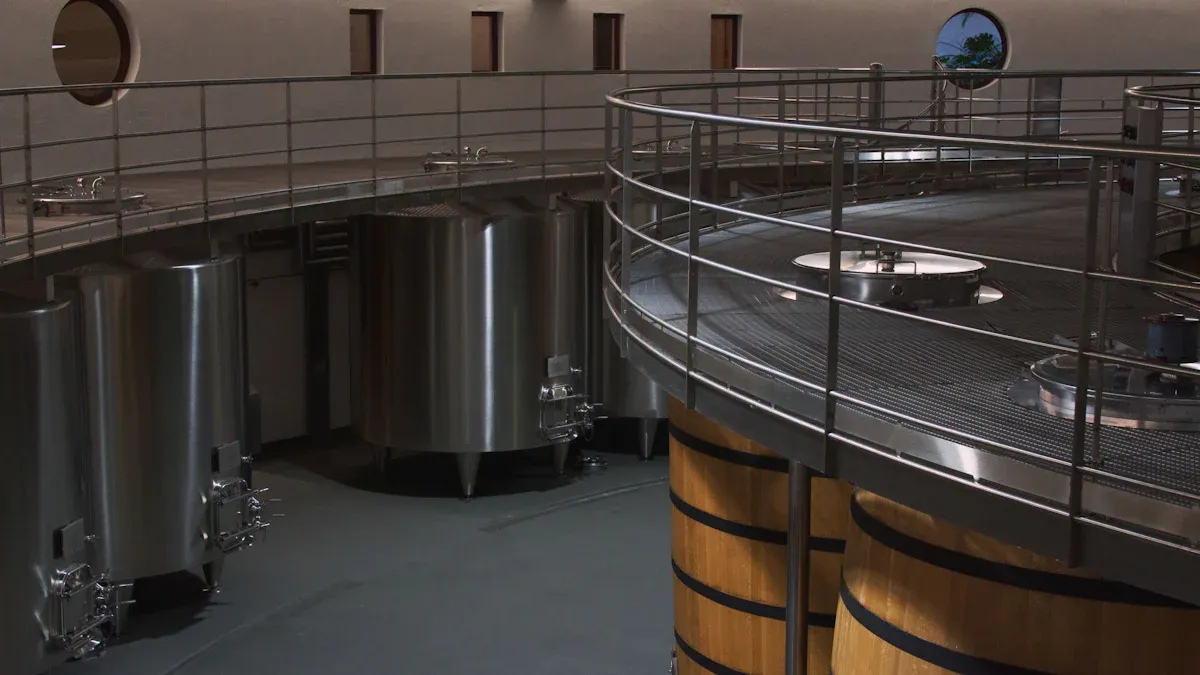
You notice that wine fermented in stainless steel tanks stands out for its crispness and freshness compared to oak-aged wine. Stainless steel tanks keep the original fruit flavors and acidity intact, so you taste a clean, vibrant profile in every sip. The non-reactive material does not add extra flavors, letting pure grape aromas shine. Temperature control in these tanks also helps maintain quality and prevents unwanted changes. When you think about factors to consider when choosing a fermentation vessel, remember that your choice shapes the entire sensory experience of wine.
Stainless Steel Tanks
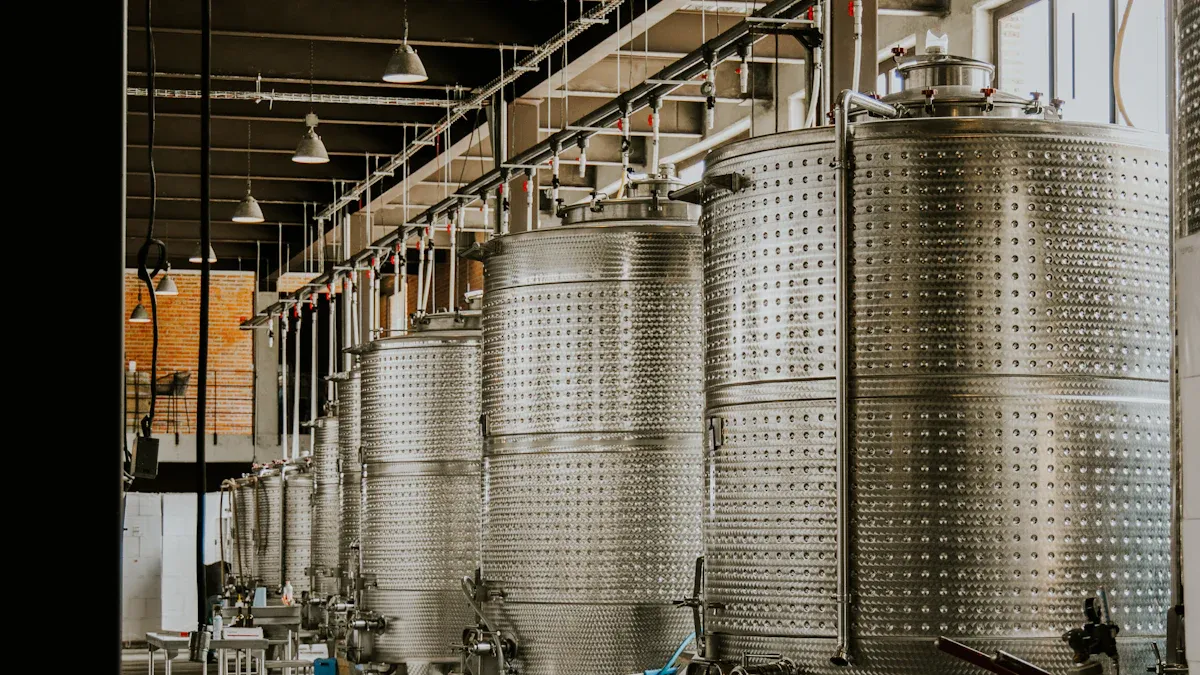
Neutral Vessel Benefits
When you choose stainless steel tanks for wine fermentation, you select a vessel that does not change the wine’s natural character. These tanks act as neutral containers. They do not allow oxygen to pass through, unlike wooden barrels. This means you keep the original flavors of the grape. You also avoid extra tastes or odors that can come from other materials.
Here are some reasons why stainless steel tanks serve as neutral vessels:
- They do not react with grape juice during fermentation.
- They do not add any flavors or aromas to the wine.
- They help you keep the wine’s fresh fruit notes.
- They allow you to control the fermentation process closely.
A scientific study found that wines made in stainless steel tanks had the highest levels of natural aroma compounds. This shows that the tanks do not change the wine’s chemistry. You get a true taste of the grape and the vineyard.
You can see the main material properties of stainless steel tanks in the table below:
| Material Property | Explanation |
|---|---|
| Corrosion Resistance | Stainless steel resists acidic grape juice corrosion better than wooden barrels, ensuring durability. |
| Easy to Clean | Smooth, non-porous surface discourages bacterial growth and allows easy sanitation; CIP systems can be integrated. |
| Temperature Control | Maintains consistent temperature, critical for fermentation quality. |
| Stable Structure | High strength and pressure resistance withstand fermentation pressures, reducing leakage or damage risks. |
| Chemical Inertness | Does not react with grape juice, preserving the wine’s original flavor without imparting odors or tastes. |
Preserving Fruit and Acidity
Stainless steel tanks help you keep the wine’s natural fruit and acidity during fermentation. The tanks have smooth, non-porous surfaces. This makes them easy to clean and keeps bacteria away. You can also use built-in cooling systems to control the temperature. This is important because it stops unwanted chemical changes that could lower the wine’s acidity.
The airtight seal of stainless steel tanks keeps oxygen out. This protects the wine from oxidation, which can dull the fruit flavors and reduce freshness. You get a wine that tastes bright and lively. The advantages of stainless steel tanks include their ability to maintain flavor preservation and support the pure taste of the grape.
You can use stainless steel tanks for both small and large batches. They come in many sizes and can be customized for your needs. This flexibility helps you scale up production while keeping quality high. Over time, you save money because these tanks last for decades and need little maintenance.
Oak Barrels
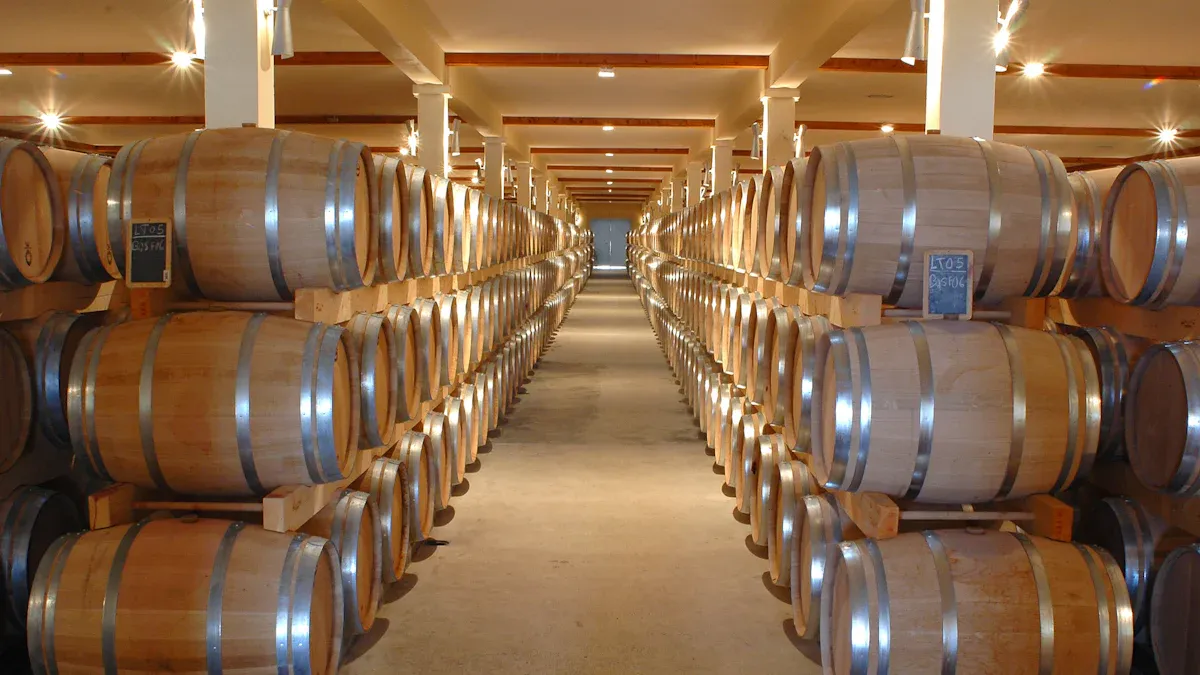
Flavor and Texture Changes
When you ferment wine in oak barrels, you introduce a world of new flavors and textures. Oak barrels release compounds such as vanillin, oak lactone, guaiacol, furfural, syringaldehyde, and eugenol. These compounds give wine notes of vanilla, coconut, smoke, clove, and dried fruit. The type of oak, whether American or European, and the level of barrel toasting, change the final taste. American oak barrels often create sweeter, bolder flavors like vanilla and caramel. European oak barrels add more spice and woody notes.
You notice that oak barrels do more than add flavor. They change the texture of wine. The wood releases tannins, which soften over time. This process makes the wine feel smoother in your mouth. Oak barrels also help clarify the wine and reduce astringency. The chemical reactions between anthocyanins and tannins, along with oxidation, create a richer, more complex wine. You experience flavor enhancement and complexity that stainless steel tanks cannot provide.
Tip: If you want wine with vanilla, spice, or smoky notes, choose wine aged in oak barrels. The barrel’s origin and toasting level make a big difference in taste.
Oxygenation Effects
Oak barrels allow slow, controlled oxygen exposure. The wood’s pores let tiny amounts of oxygen enter the wine. This micro-oxygenation helps soften tannins and stabilize color. Oxygen reacts with polyphenols and wood-derived ellagitannins, which leads to browning and deeper flavors. Over time, these reactions make the wine smoother and more stable.
You see that oxygen exposure in oak barrels supports malolactic fermentation. This process changes sharp acids into softer ones, giving the wine a creamy texture. The slow oxygen intake during aging helps develop complexity and balance. In contrast, stainless steel tanks keep oxygen out, so the wine stays crisp and fresh.
Here is a table comparing oxygen exposure in different vessels:
| Fermentation Vessel | Oxygen Exposure Characteristics |
|---|---|
| Stainless Steel Tanks | Airtight, minimal oxygen exposure, preserves wine freshness |
| Oak Barrels | Slow, controlled oxygen exposure, softens tannins, stabilizes color, develops complexity |
Oak barrels play a key role in aging. You get wines with deeper flavors, smoother textures, and greater stability. The choice of oak barrels shapes the wine’s journey from fermentation to aging, making each bottle unique.
Comparing Stainless Steel Tanks and Oak Barrels
Sensory Differences
When you taste wine, you notice clear differences between wines made in stainless steel tanks and those made in oak barrels. Stainless steel tanks keep the wine’s fruit flavors bright and pure. You often find aromas like passion fruit, grapefruit, guava, pineapple, and dried apple in wines fermented this way. These tanks do not add extra flavors, so you experience the grape’s true character.
Oak barrels, on the other hand, change the wine’s aroma and taste. Wines aged in new oak barrels develop notes of vanilla, orange blossom, roasted coffee, toffee, and caramel. The wood also brings in smoky and woody scents. A sensory analysis study on Cabernet Sauvignon showed that judges could easily tell the difference between wines fermented in stainless steel tanks and those in oak barrels. More than half of the judges preferred the barrel-fermented wines, especially when they noticed strong vanilla and woody aromas. The type of barrel and its toasting level can make these flavors even stronger.
Note: Winemakers choose between stainless steel tanks and oak barrels based on the style they want. Each vessel creates a unique sensory profile that evolves as the wine ages.
Here is a quick comparison of aroma profiles:
| Fermentation Vessel | Common Aromas Detected |
|---|---|
| Stainless Steel Tanks | Passion fruit, grapefruit, guava, pineapple, dried apple |
| Oak Barrels | Vanilla, orange blossom, roasted coffee, toffee, caramel |
Body and Texture
You also feel a difference in the body and texture of the wine. Stainless steel tanks produce wines that feel light and crisp. The acidity stays high, so the wine tastes fresh and lively. You get a clean finish with no extra weight on your palate.
Oak barrels give wine a fuller body and a smoother texture. The wood releases tannins, which soften the wine and make it feel rounder in your mouth. Oxygen slowly enters through the barrel, helping the wine become more complex and balanced. Over time, the wine feels richer and creamier.
When comparing stainless steel tanks and oak barrels, you see that each method shapes the wine’s mouthfeel in a special way. Stainless steel tanks highlight freshness, while oak barrels add depth and softness.
Wine Fermented in Stainless Steel Tanks: Crispness and Freshness
Bright Fruit Flavors
You experience a burst of freshness when you taste wine fermented in stainless steel tanks. These tanks do not add any outside flavors, so you get greater fruit intensity in every sip. The tanks keep the wine’s natural acidity high, which makes the fruit taste lively and sharp. You notice that Sauvignon Blanc made this way often shows lime, passionfruit, and green pepper. Unoaked Chardonnay brings fresh fruit aromas like green apple, pear, and citrus. The tanks help preserve these flavors by keeping oxygen out and allowing precise temperature control.
- Sauvignon Blanc: lime, passionfruit, green pepper
- Unoaked Chardonnay: green apple, pear, citrus
Stainless steel tanks let you taste the grape’s true character. You get a clean finish and a bright, zesty mouthfeel. The tanks do not change the wine’s chemistry, so you enjoy the pure flavors of the fruit. 🍏🍐🍋
Tip: If you want to taste the real fruit in your wine, choose bottles fermented in stainless steel tanks. You will notice the freshness and vibrant flavors right away.
Clean Profile
You find that wine fermented in stainless steel tanks stands out for its clean profile. Critics describe these wines as bright, crisp, and fresh. The tanks prevent oxygen from entering, so the wine keeps its acidity and fruit flavors. You taste a pure expression of the grape, without any extra notes from oak or other materials. This method creates wines that are easy to drink and refreshing.
| Feature | Stainless Steel Tank-Fermented Wine | Oak-Fermented Wine |
|---|---|---|
| Freshness | High | Moderate |
| Fruit Intensity | Greater fruit intensity | Layered with oak flavors |
| Acidity | Crisp | Softer |
| Added Flavors | None | Vanilla, spice, caramel |
| Profile | Clean, pure, fruit-forward | Complex, aromatic |
You notice that stainless steel tanks help winemakers produce wines with a crisp finish and clear flavors. The tanks support hygiene and consistency, so every batch tastes fresh. You enjoy wines that highlight the grape’s natural qualities. This style works well for crisp whites and light reds, giving you a refreshing experience every time.
Fermenting Wine in Stainless Steel Tanks: Process and Control
Temperature Management
When you start fermenting wine in stainless steel tanks, you gain precise control over the fermentation process. Temperature management is essential for successful wine production. You can use advanced systems to monitor and adjust the temperature in real time. Smart sensors and automated control units help you keep the fermentation liquid within the ideal range, usually between 18°C and 22°C. This range supports healthy yeast activity and prevents unwanted flavors.
Modern stainless steel tanks often include jacket cooling systems and cooling coils. These features allow you to stabilize the temperature and reduce energy consumption. External insulation layers, such as polyurethane foam, help maintain consistent conditions inside the tank. You can connect these tanks to intelligent control units with temperature probes, liquid level sensors, and pressure valves. These tools let you manage fermentation with accuracy and efficiency.
Chenma Machinery designs stainless steel tanks with advanced temperature control technology. You benefit from energy-efficient designs and smart monitoring systems. These innovations help you produce wine with stable alcohol content and bright, fresh flavors.
Tip: Accurate temperature control and consistency during fermentation prevent spoilage and ensure the wine’s quality.
Hygiene and Consistency
You need high hygiene standards when fermenting wine in stainless steel tanks. The non-porous surface of stainless steel prevents bacteria, yeasts, and other contaminants from hiding and growing. Cleaning and sanitizing the tanks is straightforward and effective. You can easily rinse, scrub, and sanitize every part of the tank, reducing the risk of microbial contamination.
Maintaining hygiene is crucial for consistent wine production. Stainless steel tanks allow you to clean thoroughly between batches, so you avoid residual flavors and bacteria. Regular maintenance and inspection help you keep the tanks in top condition. Chenma Machinery manufactures tanks that meet strict safety and quality standards, including ISO9001, ISO14001, OHSAS18001, and EU CE certifications. These certifications guarantee that your equipment supports safe and reliable wine production.
Here is a simple cleaning process for stainless steel tanks:
- Empty the tank of wine or sediment.
- Rinse with hot water to remove residues.
- Use mild cleaners to degrease if needed.
- Scrub gently with non-abrasive tools.
- Rinse again with hot water.
- Sanitize with food-grade sanitizer.
- Air dry completely.
- Inspect for damage and maintain regularly.
By following these steps, you ensure that every batch of wine meets high standards for quality and safety. Consistent hygiene leads to consistent fermentation results and better wine.
Quality in Stainless Steel Tank Fermentation
Equipment Standards
You want the best results in wine production, so you need equipment that meets strict standards. Stainless steel tanks from Chenma follow the latest international certifications. These certifications show that the tanks meet high levels of safety, environmental care, and quality. Here are some important certifications you should look for:
- ISO 9001: Ensures consistent quality in every step of production.
- ISO 14001: Focuses on protecting the environment during manufacturing.
- OHSAS 18001: Covers health and safety for workers and users.
- CE Marking: Confirms that the tanks meet European safety rules.
- UL 142: Shows safety for tanks used with flammable liquids, which is important in some wine production settings.
You can ask for documents to check these certifications. This helps you make sure your equipment meets global standards. Chenma’s tanks also use food-grade stainless steel, like AISI 304 or 316, which resists corrosion and keeps your wine safe. Skilled engineers use seamless welding and mirror polishing to make sure the tanks have no weak spots. Custom designs let you choose the right size and features for your production needs.
| Certification | What It Means for You |
|---|---|
| ISO 9001 | Reliable quality in every tank |
| ISO 14001 | Environmentally friendly production |
| OHSAS 18001 | Safe for workers and users |
| CE Marking | Meets European safety standards |
| UL 142 | Safe for flammable liquid storage |
Wine Purity
You want your wine to taste pure and fresh. The quality of your stainless steel tanks plays a big role in this. Tanks with polished interiors stop residue and microbes from building up. This keeps your wine clean during fermentation. You should inspect tanks for scratches or dents, because these can trap bacteria and spoil your wine.
High-quality tanks use food-grade materials that do not react with the wine. This means your wine keeps its natural flavors. Good tank design, with tight seals, keeps out oxygen that could spoil your wine during fermentation. Features like cooling jackets help you control temperature, which is key for safe and steady production.
To keep your tanks in top shape, you should:
- Clean them after every use with food-safe cleaners.
- Avoid using rough scrubbers that can scratch the surface.
- Store tanks in a dry, cool place when not in use.
- Keep a cleaning and inspection log for every tank.
By following these steps, you protect the purity of your wine and the quality of your production. Regular maintenance and careful use of your equipment help you make wine that is safe, fresh, and full of flavor.
Trade-Offs: What Stainless Steel Lacks
Absence of Oak Flavors
When you choose stainless steel tanks for wine fermentation, you keep the grape’s natural flavors pure. You do not get extra tastes from the vessel. Oak barrels add flavors such as vanilla, caramel, coconut, and spices. These flavors come from the wood and the process of micro-oxygenation. Many people associate these notes with luxury and sophistication. If you prefer wine with a crisp, fruit-forward profile, stainless steel tanks offer that style. You taste the grape itself, not the vessel.
However, some wine lovers want more complexity. Oak barrels create layers of aroma and taste. You notice creamy textures and smooth finishes in oak-aged wines. Stainless steel tanks do not provide these extra flavors. This difference shapes consumer preferences. Some people seek freshness and simplicity, while others want the nuanced character that oak brings.
Tip: If you enjoy wines with vanilla or spice notes, look for bottles aged in oak barrels. If you want pure fruit flavors, stainless steel tank-fermented wines are a better choice.
Here is a quick comparison:
| Feature | Stainless Steel Tanks | Oak Barrels |
|---|---|---|
| Added Flavors | None | Vanilla, caramel, spice |
| Aroma Complexity | Pure fruit | Layered, nuanced |
| Consumer Appeal | Freshness, simplicity | Luxury, sophistication |
Texture and Aging
You notice a difference in texture and aging when comparing stainless steel tanks and oak barrels. Stainless steel tanks keep wine light and crisp. The airtight environment limits oxygen exposure. This means the wine stays fresh but does not develop the soft tannins or creamy mouthfeel found in oak-aged wines. Oak barrels allow gentle oxygen exposure, which softens tannins and stabilizes color. This process helps the wine mature and gain depth.
Aging in oak barrels gives wine structure and complexity. Tannins from the wood act as natural preservatives. They help the wine age gracefully over time. You find that oak-aged wines often have a richer, layered profile. Stainless steel tanks do not add tannins or allow micro-oxygenation. Wines fermented in stainless steel tanks usually have a shorter aging potential. They are best enjoyed young, when the fruit flavors are at their brightest.
Stainless steel tanks:
- Preserve freshness and fruit character.
- Do not enhance aging potential.
- Result in wines that are crisp and ready to drink.
Oak barrels:
- Add tannins and structure.
- Improve aging potential.
- Create wines with complexity and depth.
Note: If you want wine that develops over years, oak barrel aging is the traditional choice. Stainless steel tanks are ideal for wines meant to be enjoyed soon after bottling.
Styles and Grapes for Stainless Steel Tanks
Whites and Rosés
You find that stainless steel tanks suit many wine styles, especially whites and rosés. Winemakers use these tanks to preserve the fresh, fruity character of the grapes. White wines like Riesling, Sauvignon Blanc, Pinot Gris, Melon, and Albarino show bright acidity and pure fruit flavors when fermented in stainless steel. You taste green apple, citrus, and tropical fruit notes. The tanks help keep these flavors crisp by limiting oxygen exposure and allowing precise temperature control.
Rosé wines also benefit from stainless steel fermentation. You notice that rosés made this way have lively berry aromas and a clean finish. The tanks do not add extra flavors, so you enjoy the grape’s natural taste. Winemakers often choose stainless steel for rosés because it maintains freshness and color stability.
Here is a table showing the suitability for different wine styles:
| Wine Type | Grape Varieties / Styles | Reason for Stainless Steel Fermentation |
|---|---|---|
| White Wines | Riesling, Sauvignon Blanc, Pinot Gris, Melon, Albarino | Preserve delicate fruit, vibrant acidity, and freshness |
| Rosé Wines | Grenache, Syrah, Pinot Noir | Maintain bright color, fresh berry aromas, and crisp style |
Tip: If you want a wine with a clean, fruit-forward style, look for bottles fermented in stainless steel tanks. 🍇
White wines fermented in stainless steel tanks often show varietal aromas, including green and tropical fruit notes. You experience an elegant acid taste and a fresh, lively style. The tanks help keep bitterness and astringency low, making these wines easy to drink.
Aromatic Varieties
You discover that aromatic white wines benefit greatly from stainless steel tank fermentation. Grapes like Gewürztraminer, Muscat, and Viognier have strong floral and fruity aromas. Stainless steel tanks protect these delicate aromas by creating a cool, oxygen-free environment. You get pure varietal expression because the tanks do not add any outside flavors.
Winemakers use cool-temperature fermentation, often below 60 °F (16 °C), to maximize aroma retention. The tanks’ sealed design keeps oxygen out, which helps preserve volatile compounds that give aromatic white wines their unique style. You also find that stainless steel tanks are easy to clean, reducing the risk of contamination that could spoil the wine’s aroma.
Here are some benefits of using stainless steel tanks for aromatic grape varieties:
- Preserve natural aromatic character and varietal purity.
- Allow precise temperature control for optimal aroma retention.
- Support reductive fermentation, which protects sensitive aromatic compounds.
- Avoid masking aromas with oak or malolactic fermentation.
You see that the style of aromatic white wines depends on the vessel. Stainless steel tanks help you enjoy the full range of floral, citrus, and tropical notes. Winemakers choose these tanks for their durability and versatility, making them ideal for all stages of fermentation.
Winemaker Choices
Modern Preferences
You see many winemakers today choosing stainless steel tanks for their clean and neutral qualities. These tanks make it easy for you to maintain and clean your equipment. You can control the temperature with precision, which helps you create a consistent wine every time. Stainless steel tanks do not let air in, so you keep the wine’s freshness and purity. This approach matches the modern preference for a wine style that highlights the grape’s true character.
Some winemakers experiment with concrete tanks to add different flavors or textures. However, stainless steel remains the top choice for those who want a pure, unoaked style. You notice that this trend has grown stronger as more people look for wines that taste bright and crisp. Stainless steel tanks help you achieve this goal by giving you full control over the fermentation process.
Tip: If you want to make a wine that shows off the vineyard and grape, stainless steel tanks support this modern style.
Consumer Demand
You notice that wine drinkers now want wines that keep the vineyard’s character and fruit purity. This demand pushes winemakers to use stainless steel tanks, especially for white wines. You get a clean, bright, and crisp style that many people enjoy. Oak barrels still matter, mostly for red wines, but you see a move toward using less oak to keep the grape’s natural taste.
- Many consumers prefer wines with a fresh and pure style.
- Some markets invest in high-quality oak barrels for premium wines, especially in Europe, North America, and Australia.
- Winemakers try new ideas, like hybrid barrels or different woods, to create unique styles.
- A niche market exists for small barrels, letting home winemakers explore their own style.
You see that both winemakers and consumers value the choice of fermentation vessel. The right vessel helps you create the style you want, whether that means a crisp stainless steel-fermented wine or a complex oak-aged one. The market now celebrates both purity and complexity, giving you more options to enjoy.
Technology and Innovation
Advances in Tank Design
You see many changes in how winemakers use stainless steel tanks today. New designs help you make better wine with less effort. Many tanks now have automated temperature control. This system lets you keep the wine at the perfect temperature during fermentation. You can use real-time monitoring to track how the wine changes. Some tanks even have touch screens and Wi-Fi, so you can check and adjust settings from your phone or computer. Precision-engineered agitators help mix the wine gently, saving energy and improving fermentation. Glycol cooling systems keep the temperature steady, which helps you get the best flavors from your grapes. You can also choose tanks that fit your winery’s needs, with custom sizes and modular setups. These features make your work easier and help you produce wine with a clean, fresh taste.
Here is a table showing some recent innovations in stainless steel tank design:
| Innovation Aspect | Description | Brand(s) |
|---|---|---|
| Automated temperature control | Precisely regulates fermentation temperature for consistent wine quality. | Chenma, Della Toffola |
| Fermentation monitoring | Real-time tracking of fermentation parameters. | Chenma, Della Toffola |
| Precision-engineered agitators | Variable-speed drives improve mixing and reduce energy use by up to 30%. | Chenma |
| Customization & modular design | Tanks can be tailored and scaled for different winery needs. | Chenma, Della Toffola, Letina |
| Durability & corrosion resistance | High-quality stainless steel ensures long-term reliability. | Speidel, Della Toffola |
These advances show how innovations in stainless steel technology help you make wine that meets modern standards.
Sustainability
You can help the environment by choosing tanks with smart features. Many new tanks have sensors and automation. These tools let you monitor fermentation from anywhere, which saves time and reduces mistakes. Cooling jackets use less energy and keep the wine at the right temperature. Some tanks have vent tubes that capture carbon dioxide, making it easier to add carbon capture systems later. You can even upgrade old tanks with new sensors to save energy and water.
- Smart tanks reduce labor and improve consistency.
- Modern cooling jackets lower energy use.
- CO2 vent tubes support carbon capture.
- IoT upgrades make old tanks more efficient.
- Spiral pumps cut down on heat and waste.
You see that these design changes help you use less water and energy. They also make it easier to protect the planet while making high-quality wine. Some companies even use recycled steel and renewable energy in their factories. By choosing these tanks, you support a cleaner and more efficient winemaking process.
You discover that wine fermented in stainless steel tanks gives you a crisp, fresh taste. You enjoy purity and high quality in every sip. You see that stainless steel tanks protect the natural grape character and keep the wine’s quality at its best. You benefit from easy cleaning, which supports quality and safety. You rely on precise temperature control for consistent quality. You trust Chenma’s advanced technology and strict standards to deliver tanks that maintain wine quality. You choose tanks with strong seals and corrosion resistance for lasting quality. You select custom designs to fit your winery and improve quality. You value after-sales support to keep your equipment at peak quality. You experience vibrant wines with clean flavors and top quality.
FAQ
What makes stainless steel tanks better for preserving wine freshness?
You get better freshness because stainless steel tanks keep oxygen out. This prevents oxidation. The tanks also let you control temperature closely. You keep the wine’s natural acidity and fruit flavors. Many winemakers use these tanks for crisp, vibrant wines.
Can you age wine in stainless steel tanks?
You can age wine in stainless steel tanks, but the wine will not gain extra flavors. The tanks do not add oak notes or tannins. You keep the wine’s original taste. Most winemakers use stainless steel for wines meant to be enjoyed young.
Are stainless steel tanks easy to clean and maintain?
Yes, you find stainless steel tanks very easy to clean. The smooth, non-porous surface stops bacteria from hiding. You can use hot water and food-safe cleaners. Many tanks support CIP (Clean-In-Place) systems for fast, thorough cleaning.
Which wine styles benefit most from stainless steel fermentation?
You see the best results with white wines, rosés, and aromatic varieties. Grapes like Sauvignon Blanc, Riesling, and Muscat keep their bright fruit and floral notes. Stainless steel tanks help you make wines with pure, fresh flavors.

